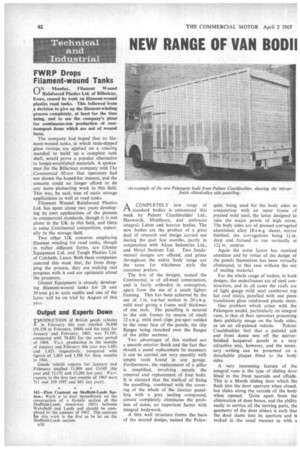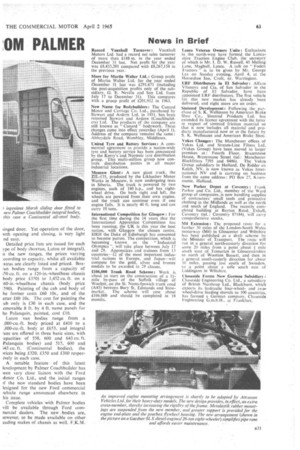NEW RANGE OF VAN BODII PALMER
Page 64

Page 65

If you've noticed an error in this article please click here to report it so we can fix it.
FWRP Drops Filament-wound Tanks
ON Monday, Filament Wound Reinforced Plastics Ltd. of Billericay, Essex, ceased its work on filament-wound plastics road tanks. This followed from a decision to give up the filament-winding process completely, at least for the time being, and to use the company's plant for continuous-run production of nontransport items which are not of wound form.
The company had hoped that its filament-wound tanks, in which resin-dipped glass rovings are applied on a rotating mandrel to build up a complete tank shell, would prove a popular alternative to longer-established materials. A spokesman for the Billericay company told The :Commercial Motor that operators had not shown the hoped-for interest, and the concern could no longer afford to do any more pioneering work in this field. This was, he said, true of static storage applications as well as road tanks.
Filament Wound Reinforced Plastics Ltd. has spent about two years developing its own applications of the process to commercial standards, though it is not alone in the UK in this field, and there is some Continental competition, especially in the storage field.
Two other UK concerns employing filament winding for road tanks, though in rather different forms, are Gloster Equipment Ltd. and Tough Plastics Ltd. of Culcheth, Lancs. Both these companies asserted this week that, far from dropping the process, they are making real progress with it and are optimistic about the prospects. .
Gloster Equipment is already developing filament-wound tanks for 28 and 30 tons g.t.w. attic outfits and one of the latter will be on trial by August of this year.
Output and Exports Down PRODUCTION of British goods vehicles in February this year totalled 36,848 (34.154 in February, 1964) and the total for January and February, 1965, was 73,191, compared with 78.850 for the same period , of 1964. Ps.v, production in the months of January and February this year was 1,68L and 1,453 respectively, compared with figures of 1,863 and 1,588 for these months in 1964.
Goods vehicle exports for January and February totalled 11,809 and 13.045 this year and 13,17/ and 13,260 last year. P.s.v. exports in the first two months of 1965 were 711 and 539 (597 and -663 last year).
Ml—First Contract on Sheffield-Leeds Section : Work is to start immediately on the construction of a 4I-mile section of the Sheffield-Leeds motorway (M1) between Wakefield and Leeds and should be completed by the summer of 1967. The contract for this work is the first to be let on the Sheffield-Leeds section.
ul()
PtA COMPLETELY new range of standard bodies is announced this week by Palmer Coachbuilder Ltd., Hanworth, Middlesex, and embraces integral, Luton and boxvan bodies. The new bodies are the product of a great deal of research and design carried out during the past few months, partly in conjunction with Alcan Industries Ltd., and Metal Sections Ltd. Two fundamental designs are offered, and prices throughout the entire body range are the same for whichever style the customer prefers.
The first of the designs, named the Continental, is of all-steel construction, and is .fairly orthodox in conception, apart from the use of a much lighter framing. This has been achieved by the use of 1 in. top-hat section in 20 s.w.g. mild steel giving a frame wall thickness of one inch. The panelling is secured to the side frames by means of small 22 s.w.g. mild steel clips pre-spot welded to the inner face of the panels, the clip flanges being clenched over the flanges of the pillar sections.
Two advantages of this method are a smooth exterior finish and the fact that should a panel replacement be necessary it can be carried out very speedily with simple tools found in any garage. Furthermore, the replacement of a pillar is simplified, involving merely the removal and replacement of four bolts. It is claimed that the method of fixing the panelling, combined with the covering of the whole of the interior panelling with a grey sealing compound, almost completely eliminates the problem of noise, an important factor with integral bodywork.
A thin wall structure forms the basis of the second design, named the Palan
quin, being used for the body sides in conjunction with an outer frame of pressed mild steel, the latter designed to take the major points of high stress. The body sides are of pressed corrugated aluminium alloy 18 s.w.g. sheets, mirror finished, the corrugations being 11 in. deep and formed to run vertically at la in. centres.
Again the noise factor has received attention and by virtue of the design of the panels themselves has been virtually eliminated, in this case without the use of sealing material.
For the whole range of bodies, in both designs, the underframes are of steel construction, and in all cases the roofs are of light gauge mild steel cambered top hat roof sticks, panelled with one piece translucent glass reinforced plastic sheet.
One problem which arises with the Palanquin model, particularly on integral vans, is that of fleet operators presenting their publicity image on the body sides, as on an all-painted vehicle. Palmer Coachbuilder feel that a painted cab and front dome sets off the mirrorfinished lacquered panels in a very attractive way, however, and the necessary writing can be presented on a detachable plaque fitted to the body sides,
A very interesting feature of the integral vans is the type of sliding door fitted to the front nearside and offside. This is a Marsh sliding door which fits flush into the door aperture when closed, but slides along the outside of the body when opened. Quite apart from the elimination of door boxes, and the ability easily to service all the moving parts, the geometry of the door sliders is such that the door slams into its aperture and is locked in the usual manner as with a
iinged door. Yet operation of the door, ■ oth opening and closing, is very light nd easy.
Detailed price lists are issued for each ype of body (boxvan, Luton or integral), n the new ranges, the prices varying ,ccording to capacity, whilst all available :xtras are clearly listed and priced. BoxFan bodies range from a capacity of 50 cu. ft. on a 120-in.-wheelbase chassis body price £350) to 1,452 eu. ft. on a .60-in.-wheelbase chassis (body price 590). Painting of the cab and body of he farther costs £60 10s., and of the atter £80 10s. The cost for painting the sib only is £30 in each case, and the emovable 8 ft. by 4 ft. name panels for he Palanquin, painted, cost £10.
Luton van bodies range from a ,000-cu.-ft. body priced at £410 to a ,800-cu.-ft. body at £653, and integral rant are offered in three basic sizes, with :apacities of 558, 600 and 643 cu. ft. Palanquin bodies) and 515, 600 and i43 Cu. ft. (Continental bodies), the n-ices being £320, £350 and £380 respecively in each case.
A notable feature of this latest levelopment by Palmer Coachbuilder has ■ een very close liaison with the Ford vlotor Co. Ltd., and the initial ranges )1' the new standard bodies have been lesigned for the new Ford commercial /aide range announced elsewhere in his issue.
Complete vehicles with Palmer bodies viii be available through Ford cornnercial dealers. The new, bodies are, iowever, to be made available on other eading makes of chassis as well. F.K.M.


































































































































































